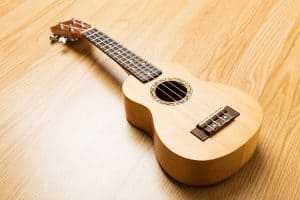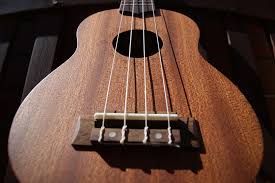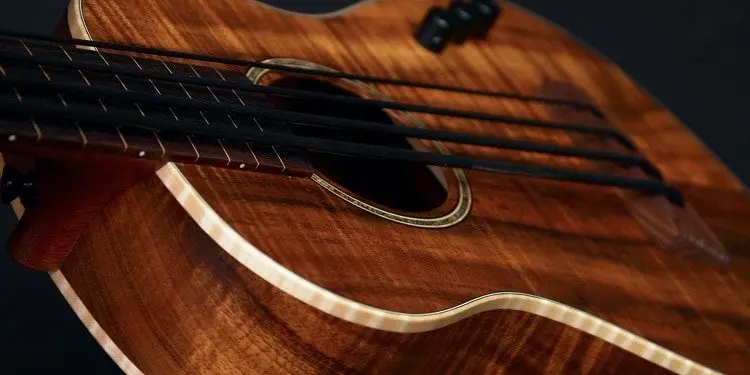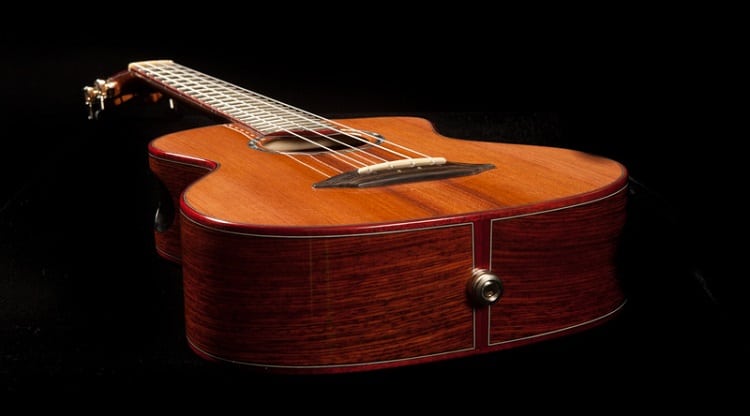 It is very important to learn basic things about every ukulele part because then you can easily restring, tune or better look after standard ukulele.
It is very important to learn basic things about every ukulele part because then you can easily restring, tune or better look after standard ukulele.
Also, it really helps to learn all those ukulele parts and types such as tenor ukuleles, baritone, concert etc, in cases when you need to start a conversation with some other players about this instrument.
Here we will describe all these important parts.
Body and Sound Hole
Ukulele has a body that got its top, back, and sides. Of course, the building wood choice is often very important for crafting either a crisp, warm and completely full sound. The material is either solid or laminated.
Another important part is the sound hole because it is located on very top of the opening in the ukulele body which is created to let some vibrations out.
Bridge
 The next part of the ukulele is the bridge. It is mounted on the body top and firmly holds a stable saddle which needs to tightly hold all those strings in their place and also above the ukuleles fretboard.
The next part of the ukulele is the bridge. It is mounted on the body top and firmly holds a stable saddle which needs to tightly hold all those strings in their place and also above the ukuleles fretboard.
Also, you will create your own knot in those bridge strings during your stringing of the ukulele.
Tuning pegs
Their other name is machine heads and tuning keys. Simply, they are those parts that tightly hold ukulele strings. By rotating and twisting them, you will be able to tune your instrument.
Four pegs appear in the headstock of the ukulele, and they are always used for regular kind of strings tuning.
 Some people point backward during tuning, and others point out instruments side, and that depends on the ukuleles style. If you want to tune your instrument from the regular tuner, then you should wisely unwind that tuner first and after that tune it back.
Some people point backward during tuning, and others point out instruments side, and that depends on the ukuleles style. If you want to tune your instrument from the regular tuner, then you should wisely unwind that tuner first and after that tune it back.
You must do that if you want to avoid nasty string breakages or over-stretching of the string, mostly if that is the metal string.
Nut
The very small ridge that’s in between instruments headstock and instrument fretboard on which ukulele strings are resting is called the nut. On it, the nut has very small notches which are able to keep instruments strings completely evenly spaced at ukuleles very top.
Also, the nut elevates all strings off instruments fretboard by a couple of millimeters so then you are able to play this by simply pressing down its strings. Well, the ukulele is unplayable without this important part, because without it the strings can slip out or rub against ukuleles frets.
Headstock
The main top part of this instrument and here you got attached those tuning pegs. Mostly, ukuleles brands logo must be in almost all cases on its headstock with a classic serial number on its back. But, there are also very rare cases of the ukulele that proves to be slightly different.
Neck and Fretboard
 The instrument’s neck is a firm and the sturdy wood piece that is positioned to support the instrument’s fretboard and also connect its headstock with ukuleles body. And, on instruments fretboard, there are simply – frets. So, the first one is the nearest to the ukulele’s headstock.
The instrument’s neck is a firm and the sturdy wood piece that is positioned to support the instrument’s fretboard and also connect its headstock with ukuleles body. And, on instruments fretboard, there are simply – frets. So, the first one is the nearest to the ukulele’s headstock.
They are usually crafted from rosewood. Also, those high-end instruments might get one made from high-quality ebony.
Fret Markers
Well, these are mostly dots, but in the cases of limited or custom, more costly models these are somewhat more artistic. So, they are here to make playing easier, so then you will quickly know exactly where you start your playing. Usually, those can appear at the seventh, tenth, third, fifth, or twelfth fret.
Strings and Frets
Of course, last crucial parts here are strings and frets. The frets are instruments metal “bars” which appear on its fretboard. And strings are those things that you pick or strum to create nice ukulele vibrations.
Because these vibrations are nicely sent trough ukuleles sound hole to its body, and thus the sound is made.

